
Indian architecture
Encyclopedia
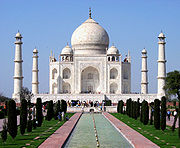
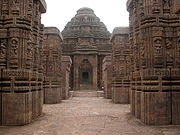
History of India
The history of India begins with evidence of human activity of Homo sapiens as long as 75,000 years ago, or with earlier hominids including Homo erectus from about 500,000 years ago. The Indus Valley Civilization, which spread and flourished in the northwestern part of the Indian subcontinent from...
, culture
Culture of India
India's languages, religions, dance, music, architecture, food and customs differ from place to place within the country, but nevertheless possess a commonality....
and religion. Indian architecture progressed with time and assimilated the many influences that came as a result of India
History of India
The history of India begins with evidence of human activity of Homo sapiens as long as 75,000 years ago, or with earlier hominids including Homo erectus from about 500,000 years ago. The Indus Valley Civilization, which spread and flourished in the northwestern part of the Indian subcontinent from...
's global discourse with other regions of the world throughout its millennia-old past. The architectural methods practiced in India are a result of examination and implementation of its established building traditions and outside cultural interactions.
Though old, this Eastern
Eastern world
__FORCETOC__The term Eastern world refers very broadly to the various cultures or social structures and philosophical systems of Eastern Asia or geographically the Eastern Culture...
tradition has also incorporated modern values as India became a modern nation state. The economic reforms of 1991 further bolstered the urban architecture of India as the country became more integrated with the world's economy. Traditional Vastu Shastra
Vastu Shastra
Vastu Shastra is an ancient doctrine which consists of precepts born out of a traditional and archaic view on how the laws of nature affect human dwellings. The designs are based on directional alignments...
remains influential in India's architecture during the contemporary era.
Indus Valley Civilization (3300 BCE-1300BCE)
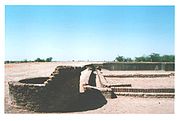

The Indus Valley is one of the world's earliest urban civilizations, along with its contemporaries, Mesopotamia and Ancient Egypt. At its peak, the Indus Civilization may have had a population of well over five million. Inhabitants of the ancient Indus river valley developed new techniques in metallurgy and handicraft (carneol products, seal carving) and produced copper, bronze, lead, and tin. The civilization is noted for its cities built of brick, roadside drainage system, and multistoried houses. The baths and toilets system the cities had is acknowledged as one of the most advanced in the ancient world. The grid layout planing of the cities with roads at exact right angles is a modern system that was implemented in the cities of this particular civilization. The urban agglomeration and production scale of this particular civilization was unsurpassed at the time and for many future centuries.
The mature phase of this civilization is known as the Harappan Civilization, as the first of its cities to be unearthed was located at Harappa, excavated in the 1920s in what was at the time the Punjab province of British India (now in Pakistan). Excavation of Harappan sites have been ongoing since 1920, with important breakthroughs occurring as recently as 1999. To date, over 1,052 cities and settlements have been found, mainly in the general region of the Ghaggar-Hakra river and its tributaries. Among the settlements were the major urban centres of Harappa, Lothal, Mohenjo-daro (UNESCO World Heritage Site), Dholavira, Kalibanga, and Rakhigarhi.
Post Maha Janapadas period (1500 BCE—200 CE)
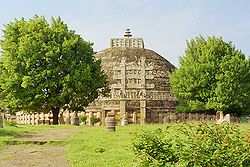

The Buddhist stupa
Stupa
A stupa is a mound-like structure containing Buddhist relics, typically the remains of Buddha, used by Buddhists as a place of worship....
, a dome shaped monument, was used in India as a commemorative monument associated with storing sacred relics. The stupa architecture was adopted in Southeast
Southeast Asia
Southeast Asia, South-East Asia, South East Asia or Southeastern Asia is a subregion of Asia, consisting of the countries that are geographically south of China, east of India, west of New Guinea and north of Australia. The region lies on the intersection of geological plates, with heavy seismic...
and East Asia
East Asia
East Asia or Eastern Asia is a subregion of Asia that can be defined in either geographical or cultural terms...
, where it became prominent as a Buddhist
Buddhism
Buddhism is a religion and philosophy encompassing a variety of traditions, beliefs and practices, largely based on teachings attributed to Siddhartha Gautama, commonly known as the Buddha . The Buddha lived and taught in the northeastern Indian subcontinent some time between the 6th and 4th...
monument used for enshrining sacred relics. Fortified cities with stūpas, vihara
Vihara
Vihara is the Sanskrit and Pali term for a Buddhist monastery. It originally meant "a secluded place in which to walk", and referred to "dwellings" or "refuges" used by wandering monks during the rainy season....
s, and temples were constructed during the Maurya empire
Maurya Empire
The Maurya Empire was a geographically extensive Iron Age historical power in ancient India, ruled by the Mauryan dynasty from 321 to 185 BC...
(c. 321–185 BCE). Wooden architecture was popular and rock cut architecture became solidified. Guard rail
Guard rail
Guard rail or guardrail, sometimes referred to as guide rail or railing, is a system designed to keep people or vehicles from straying into dangerous or off-limits areas...
s—consisting of posts, crossbars, and a coping—became a feature of safety surrounding a stupa. Temples—build on elliptical, circular, quadrilateral, or apsidal plans—were constructed using brick and timber. The Indian gateway archs, the torana
Torana
For the Australian car, see Holden Torana.A torana is a type of gateway seen in the Hindu and Buddhist architecture of the Indian subcontinent.-Meaning and uses of torana:...
, reached East Asia with the spread of Buddhism. Some scholars hold that torii
Torii
A is a traditional Japanese gate most commonly found at the entrance of or within a Shinto shrine, where it symbolically marks the transition from the profane to the sacred...
derives from the torana gates at the Buddhist historic site of Sanchi
Sanchi
Sanchi is a small village in Raisen District of the state of Madhya Pradesh, India, it is located 46 km north east of Bhopal, and 10 km from Besnagar and Vidisha in the central part of the state of Madhya Pradesh. It is the location of several Buddhist monuments dating from the 3rd...
(3rd century BCE - 11th century CE).
Rock-cut stepwell
Stepwell
Stepwells, also called bawdi or baoli , or vaav are wells or ponds in which the water can be reached by descending a set of steps. They may be covered and protected, and are often of architectural significance...
s in India date from 200-400 CE. Subsequently, the construction of wells at Dhank (550-625 CE) and stepped ponds at Bhinmal
Bhinmal
Bhinmal is a town in the Jalore District of Rajasthan, India. It is 72 km south of Jalore town. The name Bhinmal is derived from the word Shrimal.Bhinmal was old capital of the kingdom of the Gurjars during medieval period....
(850-950 CE) took place. The city of Mohenjo-daro
Mohenjo-daro
Mohenjo-daro is an archeological site situated in what is now the province of Sindh, Pakistan. Built around 2600 BC, it was one of the largest settlements of the ancient Indus Valley Civilization, and one of the world's earliest major urban settlements, existing at the same time as the...
has wells which may be the predecessors of the step well. As many as 700 wells, constructed by 3rd millennium BCE, have been discovered in just one section of the city, leading scholars to believe that 'cylindrical brick lined wells' were invented by the people of the Indus Valley Civilization. Cave temples became prominent throughout western India, incorporating various unique features to give rise to cave architecture in places such as Ajanta and Ellora.
Walled and moated cities with large gates and multi-storied buildings which consistently used arched windows and doors are important features of the architecture during this period. The Indian emperor Ashoka
Ashoka
Ashok Maurya or Ashoka , popularly known as Ashoka the Great, was an Indian emperor of the Maurya Dynasty who ruled almost all of the Indian subcontinent from ca. 269 BC to 232 BC. One of India's greatest emperors, Ashoka reigned over most of present-day India after a number of military conquests...
(rule: 273—232 BCE) established a chain of hospitals throughout the Mauryan empire by 230 BCE. One of the edicts of Ashoka
Edicts of Ashoka
The Edicts of Ashoka are a collection of 33 inscriptions on the Pillars of Ashoka, as well as boulders and cave walls, made by the Emperor Ashoka of the Mauryan dynasty during his reign from 269 BCE to 231 BCE. These inscriptions are dispersed throughout the areas of modern-day Bangladesh, India,...
(272—231 BCE) reads: "Everywhere King Piyadasi (Asoka) erected two kinds of hospitals, hospitals for people and hospitals for animals. Where there were no healing herbs for people and animals, he ordered that they be bought and planted." Buddhist architecture blended with Roman architecture
Roman architecture
Ancient Roman architecture adopted certain aspects of Ancient Greek architecture, creating a new architectural style. The Romans were indebted to their Etruscan neighbors and forefathers who supplied them with a wealth of knowledge essential for future architectural solutions, such as hydraulics...
and Hellenestic architecture
Architecture of Ancient Greece
The architecture of Ancient Greece is the architecture produced by the Greek-speaking people whose culture flourished on the Greek mainland and Peloponnesus, the Aegean Islands, and in colonies in Asia Minor and Italy for a period from about 900 BC until the 1st century AD, with the earliest...
to give rise to unique blends—such as the Greco-Buddhist school.
Early Common Era—High Middle Ages (200 CE—1200 CE)
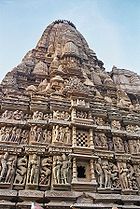
Nalanda
Nālandā is the name of an ancient center of higher learning in Bihar, India.The site of Nalanda is located in the Indian state of Bihar, about 55 miles south east of Patna, and was a Buddhist center of learning from the fifth or sixth century CE to 1197 CE. It has been called "one of the...
and Valabhi between the 4th-8th centuries. South India
South India
South India is the area encompassing India's states of Andhra Pradesh, Karnataka, Kerala and Tamil Nadu as well as the union territories of Lakshadweep and Pondicherry, occupying 19.31% of India's area...
n temple architecture—visible as a distinct tradition during the 7th century CE—is described below:
North Indian temples showed increased elevation of the wall and elaborate spire by the 10th century. Richly decorated temples—including the complex at Khajuraho
Khajuraho
The Khajuraho Group of Monuments in Khajuraho , a town in the Indian state of Madhya Pradesh, located in Chhatarpur District, about southeast of New Delhi, are one of the most popular tourist destinations in India. Khajuraho has the largest group of medieval Hindu and Jain temples, famous for...
—were constructed in Central India. Indian traders brought Indian architecture to South east Asia through various trade routes.
Late Middle Ages (1100 CE—1526 CE)
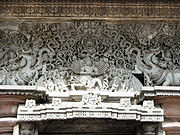
South India
South India is the area encompassing India's states of Andhra Pradesh, Karnataka, Kerala and Tamil Nadu as well as the union territories of Lakshadweep and Pondicherry, occupying 19.31% of India's area...
from their capital at Vijayanagara
Vijayanagara
Vijayanagara is in Bellary District, northern Karnataka. It is the name of the now-ruined capital city "which was regarded as the second Rome" that surrounds modern-day Hampi, of the historic Vijayanagara empire which extended over the southern part of India....
on the banks of the Tungabhadra River
Tungabhadra River
The Tungabhadra River is a sacred river in southern India that flows through the state of Karnataka to Andhra Pradesh, where it serves as the chief tributary of the Krishna River...
in present-day Karnataka
Karnataka
Karnataka , the land of the Kannadigas, is a state in South West India. It was created on 1 November 1956, with the passing of the States Reorganisation Act and this day is annually celebrated as Karnataka Rajyotsava...
. The architecture of the temples built during the reign of the Vijayanagara empire had elements of political authority. This resulted in the creation of a distinctive imperial style of architecture which featured prominently not only in temples but also in administrative structures across the deccan. The Vijayanagara style is a combination of the Chalukya, Hoysala, Pandya and Chola styles which evolved earlier in the centuries when these empires ruled and is characterised by a return to the simplistic and serene art of the past.
Hoysala architecture is the distinctive building style developed under the rule of the Hoysala Empire
Hoysala Empire
The Hoysala Empire was a prominent South Indian Kannadiga empire that ruled most of the modern day state of Karnataka between the 10th and the 14th centuries. The capital of the Hoysalas was initially located at Belur but was later moved to Halebidu....
in the region historically known as Karnata, today's Karnataka
Karnataka
Karnataka , the land of the Kannadigas, is a state in South West India. It was created on 1 November 1956, with the passing of the States Reorganisation Act and this day is annually celebrated as Karnataka Rajyotsava...
, India
India
India , officially the Republic of India , is a country in South Asia. It is the seventh-largest country by geographical area, the second-most populous country with over 1.2 billion people, and the most populous democracy in the world...
, between the 11th and the 14th centuries. Large and small temples built during this era remain as examples of the Hoysala architectural style, including the Chennakesava Temple
Chennakesava Temple
The Chennakesava Temple originally called Vijayanarayana Temple was built on the banks of the Yagachi River in Belur, an early capital of the Hoysala Empire. Belur is 40 km from Hassan city and 220 km from Bangalore, in Hassan district of Karnataka state, India. Chennakesava literally...
at Belur
Belur
Belur may refer to any of the following:* Belur, Karnataka, town in Karnataka, India* Belur, West Bengal, India, a locality on the west bank of the Hooghly River* Belur Math, the religious abbey located in Belur, West Bengal, India...
, the Hoysaleswara Temple
Hoysaleswara temple
Hoysaleswara temple is a temple dedicated to Hindu God Shiva. It was built in Halebidu during the Hoysala Empire rule in the 12th century by King Vishnuvardhana. The construction was completed in 1121 CE. During the early 14th century, Halebidu was sacked and looted by Muslim invaders from...
at Halebidu
Halebidu
Halebidu is located in Hassan District, Karnataka, India. Halebidu was the regal capital of the Hoysala Empire in the 12th century. It is home to one of the best examples of Hoysala architecture in the ornate Hoysaleswara and Kedareswara temples. Halebidu literally means ruined city...
, and the Kesava Temple at Somanathapura
Somanathapura
The Chennakesava Temple located at Somanathapura is one of the finest examples of Hoysala architecture. This temple was built by Soma, a Dandanayaka in 1268 under Hoysala king Narasimha III, when the Hoysala Empire was the major power in South India.-Deity and sculptures:The ceiling of the hall...
. Other examples of fine Hoysala craftmanship are the temples at Belavadi
Belavadi
The Veera Narayana temple is located in Belavadi , a village in Chikmagalur district of Karnataka state, India. The temple was built by the Hoysala Empire.This village was also known as Ekachakranagara, a place mentioned in Mahabharatha where Bheemasena killed the demon Bakasura and protected the...
, Amrithapura, and Nuggehalli
Nuggehalli
Nuggehalli , is a town in Hassan district of Karnataka, India. Nuggehalli is located on the Tiptur-Channarayanapatna state highway. It is about 50 km from Hassan city. It is connected by road with Bangalore, the state capital...
. Study of the Hoysala architectural style has revealed a negligible Indo-Aryan influence while the impact of Southern Indian style is more distinct. A feature of Hoysala temple architecture is its attention to detail and skilled craftmanship. The temples of Belur and Halebidu are proposed UNESCO
UNESCO
The United Nations Educational, Scientific and Cultural Organization is a specialized agency of the United Nations...
world heritage sites. About a 100 Hoysala temples survive today.
Islamic influence and Mughal Era (1526 CE-1857 CE)


Agra Fort
Agra Fort, is a monument situated at Agra, is a UNESCO World Heritage site located in Agra, Uttar Pradesh, India. It is about 2.5 km northwest of its more famous sister monument, the Taj Mahal...
at Agra
Agra
Agra a.k.a. Akbarabad is a city on the banks of the river Yamuna in the northern state of Uttar Pradesh, India, west of state capital, Lucknow and south from national capital New Delhi. With a population of 1,686,976 , it is one of the most populous cities in Uttar Pradesh and the 19th most...
(1565–74) and the walled city of Fatehpur Sikri
Fatehpur Sikri
Fatehpur Sikri is a city and a municipal board in Agra district in the state of Uttar Pradesh, India. Built near the much older Sikri, the historical city of Fatehabad, as it was first named, was constructed by Mughal emperor Akbar beginning in 1570...
(1569–74) are among the architectural achievements of this time—as is the Taj Mahal
Taj Mahal
The Taj Mahal is a white Marble mausoleum located in Agra, India. It was built by Mughal emperor Shah Jahan in memory of his third wife, Mumtaz Mahal...
, built as a tomb for Queen Mumtaz Mahal
Mumtaz Mahal
Mumtaz Mahal born as Arjumand Banu Begum was a Mughal Empress and chief consort of emperor Shah Jahan...
by Shah Jahan
Shah Jahan
Shah Jahan Shah Jahan (also spelled Shah Jehan, Shahjehan, , Persian: شاه جهان) (January 5, 1592 – January 22, 1666) Shah Jahan (also spelled Shah Jehan, Shahjehan, , Persian: شاه جهان) (January 5, 1592 – January 22, 1666) (Full title: His Imperial Majesty Al-Sultan al-'Azam wal Khaqan...
(1628–58). Employing the double dome, the recessed archway, white marble and parks while stressing on symmetry and detail was visible during the reign of Shah Jahan. Quranic verses were described on the walls of the buildings. However, the depiction of any living being—an essential part of the pre-Islamic tradition of India—was forbidden under Islam.
Some scholars hold that cultural contact with Europe
Europe
Europe is, by convention, one of the world's seven continents. Comprising the westernmost peninsula of Eurasia, Europe is generally 'divided' from Asia to its east by the watershed divides of the Ural and Caucasus Mountains, the Ural River, the Caspian and Black Seas, and the waterways connecting...
under Manuel I of Portugal
Manuel I of Portugal
Manuel I , the Fortunate , 14th king of Portugal and the Algarves was the son of Infante Ferdinand, Duke of Viseu, , by his wife, Infanta Beatrice of Portugal...
(reign: October 25, 1495—December 13, 1521) resulted in exchange of architectural influences. Little literary evidence exists to confirm the Indian influence but some scholars have nonetheless suggested a possible relation based on proximity of architectural styles.
Colonial Era (1500 CE—1947 CE)

The British, French, Dutch and the Portuguese were the main powers that colonized India.
British Colonial Era: 1615 to 1947
The British arrival in 1615 overthrew the Mughal empire. Britain reigned India for over three hundred years and their legacy still remains through building and infrastructure that populate their former colonies.
The major cities colonized during this period were Madras, Calcutta, Bombay, Delhi, Agra, Bankipore, Karachi, Nagpur, Bhopal and Hyderabad.
St Andrews Kirk, Madras is renowned for its colonial beauty. The building is circular in form and is sided by two rectangular sections one is the entrance porch. The entrance is lined with twelve colonnades and two British lions and motto of East India Company engraved on them. The interior holds sixteen columns and the dome is painted blue with decorated with gold stars.
The staple of Madras was Fort St. George, a walled squared building adjacent to the beach. Surrounding the fort was White Town settlement of British and Indian area Black Town later to be called Georgetown.
Black Town described in 1855 as “the minor streets, occupied by the natives are numerous, irregular and of various dimensions. Many of them are extremely narrow and ill-ventilated…a hallow square, the rooms opening into a courtyard in the centre."
Garden houses were originally used as weekend houses for recreational use by the upper class British. Nonetheless, the garden house became ideal a full time dwelling, deserting the fort in the 19th Century.
Calcutta – Madras and Calcutta were similar bordered by water and division of Indian in the north and British in the south. An Englishwoman noted in 1750 “the banks of the river are as one may say absolutely studded with elegant mansions called here as at Madras, garden houses.” Esplanade-row is fronts the fort with lined palaces.
Indian villages in these areas consisted of clay and straw houses, later transformed into a metropolis of brick and stone.
The Victoria Memorial in Calcutta, is the most effective symbolism of British Empire, built as a monument in tribute to Queen Victoria’s reign. The plan of the building consists of one large central part covered with a larger dome. Colonnades separate the two chambers. Each corner holds a smaller dome and is floored with marble plinth. The memorial stands on 26 hectares of garden surrounded by reflective pools.
French: 1673 to 1954
The French colonized a fishing village (Pondicherry) in Tamil Nadu and transformed it into a flourishing port-town. The town was built on the French grid pattern and features neat sectors and perpendicular streets and divided into two sectors, French Quarter (Ville Blanche) and the Indian quarter (Ville Noire). French styled villas were styled with long compounds and stately walls, lined houses with verandas, large French doors and grills. Infrastructure such as banks, police station and Pondicherry International Port still hold the French presence.
To preserve Pondicherry an organization names INTACH was formed. Authorization is needed from INTACH, to annihilate any original French Architecture.
French expanded their empire by colonizing coastal towns, Yanam in Andhra Pradesh, Karaikal in Tamil Nadu and Mahe in Kerala with a French atmosphere of quiet towns around beaches. French spelling on signage and traffic signs still remains.
Dutch: 1605 to 1825
The Dutch entered India with the only interests of Trade in the early 17th Century. During their 200 years in India, they colonized Surat, Bharuch, Venrula, Ahmedabad, Malabar Coast, Kochi and Sadras.
Surat – a Dutch factory in 1630’s
Bharuch: Trading Post of the Dutch East India Company had a Dutch cemetery.
Venrula: a warehouse was built for 3000 Guilders by Leendart Janszoons and a castle for the protection of the Dutch.
Ahmedabad: The Dutch cemetery lies on the bank of Kankaria lake. It holds a mix of Indian and European styled graves, with domed tombs, pyramids, walled and plain grave stones.
Malabar Coast Kochi:
The Dutch Palace (Mattancherry Palace) – The palace was originally built by the Portuguese, it fell into the hands of the Dutch when the Portuguese lost control of Kochi.
Dutch cemetery – The cemetery runs parallel to the beach and is the oldest European cemetery in India. It holds 104 tombs that visually narrate the Dutch influence in Architecture during the era. The cemetery is guarded by heavy walls and the entrance pillar still carries the original calligraphic inscription “1724”
David Hall – which was the residence of the famous Dutch Commander and Governor of Kochi, Adriaan van Reed lot Drakestein was built in 1695. The hall has been restored as a cultural centre and art café for young, visual and performing artists.
Bastion bungalow – This Dutch styled building near the Fort Kochi beach was built to protect the harbor.
Thakur House – the Dutch built this bungalow overlooking the sea as a club.
Sadras – 17 km (11 mi) from the rock cut temples of Mamallapuram is another Dutch settlement.
Pullicat – Pullicat lake 55 km north of Madras is a million years old and the second largest lagoon in India. It was the most important trading post of the Dutch. They built two cemeteries. One was ruined due to negligence and at the entrance is flanked by stone pillars, having 76 tombs. Images of skeletons are carved onto the gravestones, symbolizing life and death.
Portuguese: 1498 to 1961
The Portuguese arrived as merchants in the 1498 and were more driven by a Catholic missionary zeal than gaining powers in India. The Portuguese gained a foothold Goa and ruled for 400 hundred years.
Portuguese dominance in Goa still remains. Their missionary spirit built many magnificent cathedrals, churches, basilicas and seminaries.
The Basilica of Bom Jesus (Good Jesus), Old Goa, former capital during the Portugal rule. The three storied Renaissance styled church was built of plaster and laterite in 1605, it holds the body of St.Francis. The interior is built in a Mosaic- Corinthian style and adorned with wood and gold leaf. The walls embrace old painting of saints as the floor is laid with pure white marble.
The Portuguese - Catholic houses faced the street with unique large ornamental windows opening onto verendahs. Bold colours were painted on houses constructing distinct identity, allowing the sailors to recognize their houses from sea. The covered porches and verandas were designed for socializing contrary to the Hindu styled housing. Front doors were lined with coloumns and railings were popular in embellishment.
The interior of Goan-Portuguese houses consisted of elaborate patterns created with tiles imported from Europe and a false ceiling installed of wood. The walls are painted with bright colours contrasting to the earthy coloured furniture.
The walls were made of out mud or laterite stone and coloured with vegetable and natural dyes. Gateposts and compound walls were craved with great detail.
Indian Architecture continued to flourish as they took influence from the colonies. Indian Architecture further shaped as they combined the colonial influences with traditional Architecture.
Republic of India (1947 CE—present)
In recent times there has been a movement of population from rural areas to urban centres of industry, leading to price rise in property in various cities of India. Urban housing in India balances space constrictions and is aimed to serve the working class. Indian government has accepted World Trade Organisation’s General Agreement on Trade in ServicesGeneral Agreement on Trade in Services
The General Agreement on Trade in Services is a treaty of the World Trade Organization that entered into force in January 1995 as a result of the Uruguay Round negotiations...
(GATS), enabling foreign architects to practice in India, and thereby adding to the plurality of Indian building traditions. Growing awareness of ecology has influenced architecture in India during modern times.
A significant feature of India's architecture is the courtyard. Klaus-Peter Gast (2007) elaborates on the significance of courtyards in India:
Climate responsive architecture has long been a feature of India's architecture but has been losing its significance as of late. Indian architecture reflects its various socio-cultural sensibilities which vary from region to region. Certain areas are traditionally held to be belonging to women. Villages in India have features such as courtyards, loggias, terraces and balconies. Calico, chintz
Chintz
Chintz is glazed calico cloth printed with flowers and other patterns in different colours. Unglazed calico is called "cretonne". The word Calico is derived from the name of the Indian city Calicut to which it had a manufacturing association.-History:Chintz was originally a woodblock printed,...
, and palampore
Palampore
A palampore is a type of hand-painted and mordant-dyed bed cover that was made in India for the export market during the eighteenth century and very early nineteenth century. Only the wealthiest classes could afford to buy palampore; therefore, the few examples that have survived are often quite...
—of Indian origin—highlight the assimilation of Indian textiles in global interior design. Roshandan
Roshandan
A roshandan is a feature of many dwelling structures in North India and Pakistan that is a combined skylight and ventilating window. Roshandans are usually located high on a room's walls, and often on top of windows. They are essentially smaller windows that swivel open when needed...
s, which are skylights-cum-ventilators, are a common feature in Indian homes, especially in North India
North India
North India, known natively as Uttar Bhārat or Shumālī Hindustān , is a loosely defined region in the northern part of India. The exact meaning of the term varies by usage...
.
Architecture of India in detail
- Western Chalukya architectureWestern Chalukya architectureWestern Chalukya architecture , also known as Kalyani Chalukya or Later Chalukya architecture, is the distinctive style of ornamented architecture that evolved during the rule of the Western Chalukya Empire in the Tungabhadra region of central Karnataka, India, during the 11th and 12th centuries...
- Badami Chalukya architectureBadami Chalukya ArchitectureThe Badami Chalukya architecture was a temple building idiom that evolved in the time period of 5th – 8th centuries AD. in the area of Malaprabha basin, in present day Bagalkot district of Karnataka state. This style is sometimes called the Vesara style and Chalukya style...
- Hoysala architectureHoysala architectureHoysala architecture is the building style developed under the rule of the Hoysala Empire between the 11th and 14th centuries, in the region known today as Karnataka, a state of India. Hoysala influence was at its peak in the 13th century, when it dominated the Southern Deccan Plateau region...
- Vijayanagara architecture
- Dravidian architectureDravidian architectureDravidian architecture was a style of architecture that emerged thousands of years ago in Southern part of the Indian subcontinent or South India. They consist primarily of pyramid shaped temples called Koils which are dependent on intricate carved stone in order to create a step design consisting...
- Architecture of KarnatakaArchitecture of KarnatakaThe Architecture of Karnataka can be traced to 345 AD with that of the Kadamba Dynasty. Karnataka is a state in the southern part of India originally known as the State of Mysore. Over the centuries, architectural monuments within the region displayed a diversity of influences, often relaying much...
- Hindu temple architectureHindu temple architectureIndia's temple architecture developed from the sthapathis' and shilpis' creativit, but n general these are from the Vishwakarma . A small Hindu temple consists of an inner sanctum, the garbha griha or womb-chamber, in which the image is housed, often circumambulation, a congregation hall, and...
- Hoysala architectureHoysala architectureHoysala architecture is the building style developed under the rule of the Hoysala Empire between the 11th and 14th centuries, in the region known today as Karnataka, a state of India. Hoysala influence was at its peak in the 13th century, when it dominated the Southern Deccan Plateau region...
- Badami cave temples
- Temples of North KarnatakaTemples of North KarnatakaTemples of North KarnatakaNorth Karnataka has innumerable sites in the Temple Map of Karnataka, India, with its some of its still surviving monuments going back to the 7th century AD. The Badami Chalukyas were the builders of rock cut caves and ancient temple complexes...
- Indian vernacular architectureIndian vernacular architectureIndian vernacular architecture is the informal, functional architecture of structures, often in rural areas of India, built of local materials and designed to meet the needs of the local people...
- Rajasthani architectureRajasthani architectureMāru-Gurjara Architecture originated somewhere in sixth century in and around areas of Rajasthan.-Etymology:The name Maru Gurjara has its genesis in the fact that during ancient times, Rajasthan and Gujarat had similarities in ethnic, cultural and political aspects of the society...
- HemadpanthiHemadpanthiHemadpanthi Sculpture is an architectural form or a style, which is named after its introducer and founder, the prime minister named Hemadpant in the court of Seuna Yadavas of Devagiri. The period of discovery was during the 13th Century in Maharashtra. Main ingredients in the construction include...
- Jainism in North KarnatakaJainism in North Karnataka-Introduction:Jainism in North Karnataka flourished under the Chalukyas, Kadamba and Rashtrakutas, and Vijayanagara empire.Imbued with an intense religious feeling, lavish patronage was extended towards the building of basadis, temples and magnificent statues...
- List of Indian architects
- Kalinga ArchitectureKalinga architectureThe Kaḷinga architectural style is a style which flourished in the ancient Kalinga region or present eastern Indian state of Orissa and northern Andhra Pradesh. The style consists of three distinct types of temples: Rekha Deula, Pidha Deula and Khakhara Deula...
- Architecture of KeralaArchitecture of KeralaKerala architecture is a kind of architectural style that is mostly found in Indian state of Kerala. Kerala style of architecture is one of the most unique in India, especially in its striking contrast to Dravidian architecture, other Tamil architecture popularly seen in South India and its close...
Further reading
- Fletcher, BanisterBanister FletcherSir Banister Flight Fletcher was an English architect and architectural historian, as was his father, also named Banister Fletcher....
; Cruickshank, Dan, Sir Banister Fletcher's a History of Architecture, Architectural Press, 20th edition, 1996 (first published 1896). ISBN 0750622679. Cf. Part Four, Chapter 26.

